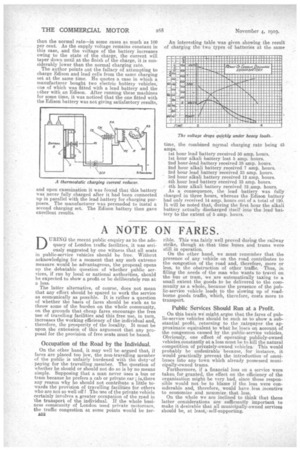A NOTE ON FARES.
Page 24

If you've noticed an error in this article please click here to report it so we can fix it.
DURING the recent public enquiry as to the adequacy of London traffic facilities, it was seriously suggested by one witness that all seats in public-service vehicles should be free. Without acknowledging for a moment that any such extreme measure would be advantageous, the proposal opens up the debatable question of whether public services, if run by local or national authorities, should be expected to show a profit or be deliberately run at a loss.
The latter alternative, of course, does not mean that any effort should be spared to work the service as economically as possible. It is rather a question of whether the basis of fares should be such as to throw some of the burden on the whole community, on the grounds that cheap fares encourage the free use of travelling facilities and this free use, in turn, increases the working efficiency of the individual and, therefore, the prosperity of the locality. It must be upon the extension. of this argument that any proposal for the provision of free seats must be based.
Occupation of the Road by the Individual.
On the other hand, it may well be argued that, it fares are placed too low, the non-travelling member of the public is unfairly burdened with the duty of paying for the travelling member. The, question of whether he should or should not do so is by no means simple. Supposing that a man never uses a bus or tram because he prefers a cab. or private car; is,there any reason why he should not contribute a little towards the provision of travelling facilities for others who are not so well off? The use of the private vehicle certainly involves a greater occupation of the read in the transport of the individual. If the whole business community of London used private motorcars, the traffic congestion at some points would be ter 252 ribIe. This was fairly well proved during the railway strike, though at that time buses and trams were still in operation. On the other hand, we must remember that the presence of any vehicle on the road contributes to the congestion of the road and, therefore, more or less, to the obstruction of other traffic. Thus, in filling the needs of the man who wants to travel on the bus or tram, we are automatically taxing to a small extent the goods to be delivered to the community as a whole, because the presence of the Public-service vehicle leads to the slowing up of roadborne goods traffic, which, therefore, costs more to transport.
Public Services Should Run at a Profit.
On this basis we might argue that the fares of publie-service vehicles should be such as to show a substantial profit. returning to the ratepayer the approximate equivalent to what he loses on account of the congestion caused by the public-service vehicles, Obviously, one effect of operating publicly-owned vehicles, constantly at a loss must be to kill the natural competition of privately-owned vehicles. This would probably be undesirable because, for instance, it
would practically prevent the introduction of omni i buses into any town which already possessed muni cipally-owned trams. Furthermore, if a financial loss on a service were taken for granted, the effect on the efficiency of the organization might be very bad, since those responsible would not be to blame if the loss were considerable and, therefore, would have less incentive to economize and minimize that loss.
On the whole we are inclined to thick that these latter considerations are sufficiently important to make it desirable that all municipally-owned services should be, at least,. self-supporting.


























